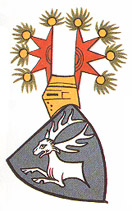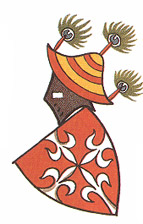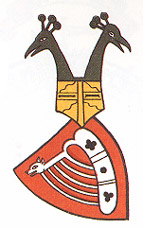

Songbook Arms (peacocks)
This grouping of arms with peacocks in the crest are from the German Weingarten and Heidelberg minnesinger songbooks:
In Provence and Languedoc began the generating of love songs. Between Alpine glaciers and the sun-baked Pyrennes, from the vineyards of the Loire Valley tothe gardens of Cote d'Azur and Cote Vermeille, a civilization developed where poetry and the Minne (the ideal love, sublime love) was law. These laws were said to have been given to the first troubadour by a hawk who sat on a branch of a golden oak tree. Minne excluded carnal love and marraige. It was more a union between souls and two hearts. Marriage was a union of two physical bodies.
It was thought that with marraige Minne and poetry die. Minne was pure love without embodiment. A troubadour would swear fidelity to his lady and as a token of her love would be a golden ring and when he stood, a kiss. That was the first kiss.
Minnesingers were medieval German knights, poets, and singer of Minne, or courtly love. Originally imitators of Provençal troubadours, minnesingers developed their own style in the 13th and 14th cent. Some of their poems are among the best of Middle High German lyric verse. Important exponents of Minnesang included Heinrich von Morungen (c.1158-1222),
Walther von der Vogelweide (1170-1228), and Oswald von Wolkenstein, as well as Gottfried von Strassburg,
Wolfram von Eschenbach (1170-1220), and other authors of epics. Wagner's opera Tannhäuser is based on minnesinger art and tradition.

| 
|  |

| 
|  |
to be continued...
SOURCES:
Fox-Davies, Arthur Charles. Heraldry: A Pictorial Archive For Artists & Designers. New York: Dover Publications, Inc., 1001.
Gwynn-Jones (Garter King of Arms-U.K.). Peter. The Art of Heraldry: Origins, Symbols & Design. New York: Barnes & Noble Books, 1998.
Wise, Terence. Medieval Heraldry. Oxford: Osprey Publishing Ltd., 1980.

This page was last updated on February 18, 2008
